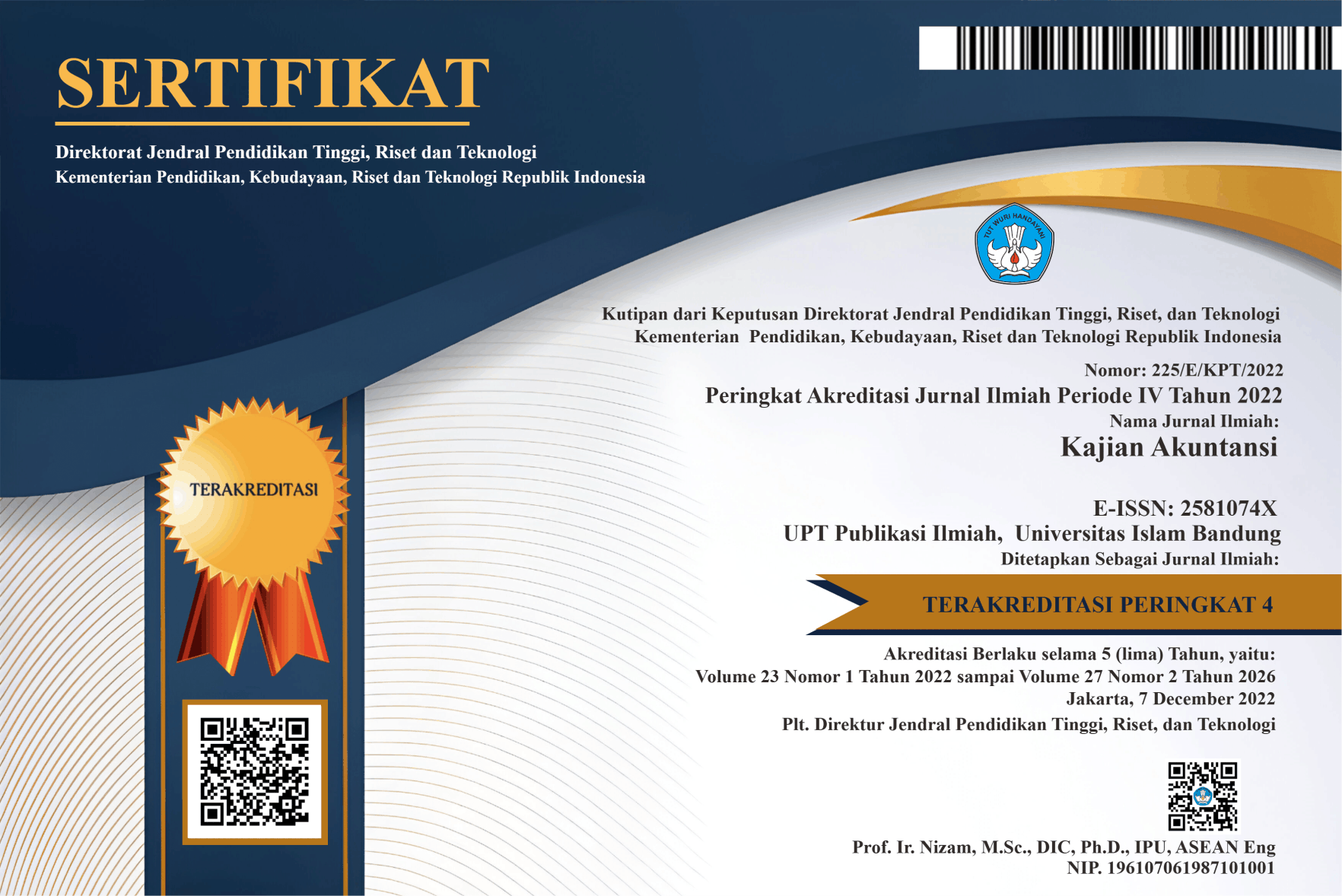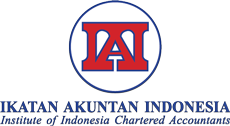SMALL AND MEDIUM ENTERPRISE DEVELOPMENT STRATEGY: SWOT-BALANCED SCORECARD PERSPECTIVE
DOI:
https://doi.org/10.29313/kajian_akuntansi.v24i2.2502Keywords:
Balanced Scorecard, Business Strategy, SWOT AnalysisAbstract
This study aims to find out what strategy should be used by UKM Rai SJ Leather by using SWOT analysis, where the Balanced Scorecard is used as the basis for strategy formulation. Informants were selected based on the consideration that the person was considered to know the most about various information related to the company's operational strategy. In this study, the authors use primary data and secondary data. The research method used is a qualitative method. Data collection techniques using library research, interviews, and internet studies. The data analysis technique was carried out by means of data reduction, data presentation, and verification. The results showed that after weighting using the IFAS matrix with a value of 1.95 and the EFAS matrix with a value of -0.5, the Rai SJ Leather SME is located in quadrant two. The strategy that must be used in quadrant two is concentric diversification by utilizing strengths to overcome various threats. The strategy from the growth and learning perspective is that SMEs must recruit human resources who have knowledge and abilities in the field of technology and quality control; in the internal business process perspective, the strategy that must be carried out is to make new innovations, the strategy from the customer perspective is to increase the brand to be recognized more widely, the strategy on a financial perspective is to increase revenue.
Keywords: Balanced Scorecard, Business Strategy, SWOT Analysis.
References
Alobaidy, RJAE (2019). Integration of lean accounting techniques and a balanced scorecard to evaluate the performance of economic units: An exploratory or applied study in Iraq. Periodicals of Engineering and Natural Sciences, 7 (4), 1812–1820. https://doi.org/10.21533/pen.v7i4.882
Bach, MP, Klinčar, A., Aleksić, A., Jelavić, SR, & Zeqiri, J. (2023). Supply Chain Management Maturity and Business Performance: The Balanced Scorecard Perspective. MDPI, 13 (4). https://doi.org/https://doi.org/10.3390/app13042065
Bartik, AW, Bertrand, M., Cullen, Z., & Stanton, C. (2020). The Impact of Covid-19 on Small Business Outcomes and Expectations. PNAS. https://doi.org/https://doi.org/10.1073/pnas.2006991117
BPS. (2020). Analysis of the Results of the Covid-19 Impact Survey on Business Players . 30 pages. https://www.bps.go.id/publication/2020/09/15/9efe2fbda7d674c09ffd0978/analysis-hasil-survei-dampak-covid-19-terhadap-pelaku-usaha.html
Costa, MLR da, Giani, EG de S., & Galdamez, EVC (2019). Vision of The Balanced Scorecard in Micro, Small, and Medium Enterprises. Electronic Journal of Management & Systems, 14 (1), 131–141. https://doi.org/10.20985/1980-5160.2019.v14n1.1505
Damara, G. (2018). Cerah Jaya Abadi Performance Assessment Using the Balanced Scorecard Method. Journal of Business Management and Start-Up, 3 (1), 72–80.
Feriana, GW (2020). Management Accounting. CV Hira Tech.
Hernawati, N., Kuntorini, RS, Pramono, IP, Accounting, P., Economics, F., & Business, D. (2019). The Influence of Knowledge of Financial Statements on the Performance of UMKM Cibuntu Tofu Application of Knowledge of Financial Statements On the Performance of UMKM Cibuntu Tofu. https://ejournal.unisba.ac.id/index.php/kajian_akunansi/article/view/6240/pdf
Laguecir, A., Kern, A., & Kharoubi, C. (2020). Management accounting systems in institutional complexity: Hysteresis and boundaries of practices in social housing. Management Accounting Research, 49 (August). https://doi.org/10.1016/j.mar.2020.100715
Lestyarindi, A., & Hidayat, MS (2018). SWOT and BSC analysis on CV Dua Putra. Bisman (Business & Management): The Journal Of Business and Management, 1 (1), 101–126.
Mustikowati, RI, & Tysari, I. (2015). Entrepreneurial Orientation, Innovation, and Business Strategy to Improve Company Performance (Study at UKM Sentra Malang Regency). Journal of Modernization Economics, 10 (1), 23. https://doi.org/10.21067/jem.v10i1.771
Nurrohmat, A., & Lestari, R. (2021). The Effect of Job Satisfaction on Employee Performance. Journal of Accounting Research, 2 (2), 82–85. https://doi.org/10.35697/jrbi.v2i2.71
OECD. (2020). Covid-19: SME Policy Responses. Tackling Coronavirus (COVID-19): Contributing to a Global Effort, March 1–55. https://oecd.dam-broadcast.com/pm_7379_119_119680-di6h3qgi4x.pdf
Pedroso, E., Gomes, CF, & Yasin, MM (2020). Management accounting systems: an organizational competitive performance perspective. Benchmarking, 27 (6), 1843–1874. https://doi.org/10.1108/BIJ-12-2019-0547
Rahman, R. (2020). 37,000 SMEs hit by COVID-19 crisis as government prepares aid. The Jakarta Post.
Rangkuti, F. (2014). SWOT Analysis: Techniques for Dissecting Business Cases. Main Library Gramedia.
Rudianto. (2012). Introduction to Accounting Concepts and Techniques for Preparing Financial Statements. Erlangga.
Sarfin, GR, Budiman, R., & Prima, F. (2020). Formulation of a Competitive Strategy for Umkm Taro Kunti Products Using the Swot, Cpm, and Qspm Methods. Tanjungpura University TIN Journal, 178–185. https://jurnal.untan.ac.id/index.php/jtinUNTAN/article/view/50776%0Ahttps://jurnal.untan.ac.id/index.php/jtinUNTAN/article/download/50776/75676591269
Sari, IA, Wahyuhastuti, N., & Yunus, M. (2021). SMEs Development Strategy in Central Java Province Through the Balanced Scorecard SWOT Analysis Approach. MONEX, 10 (2).
Suarta, IM, Citrawati Purna, PI, & Astri Pramitari, IGA (2021). Design of a Profit and Loss Report Information System for Micro, Small, and Medium Enterprises. Journal of Accounting Studies, 5 (1), 127. https://doi.org/10.33603/jka.v5i1.4567
Suwarno, S., & Pramono, T. (2020). SWOT Analysis of Balanced Scorecard (BSC) in Batik Umkm Development Policy in Kediri Regency. E-Journal of Economics and Business, Udayana University, 7, 653. https://doi.org/10.24843/eeb.2020.v09.i07.p04
Wibowo, EW (2017). Performance Analysis Study of Micro, Small, and Medium Enterprises (Umkm) Using the Balanced Scorecard Method. Journal of Business Lentera, 6 (2), 25. https://doi.org/10.34127/jrlab.v6i2.188
Zyznarska-Dworczak, B. (2018). The development perspectives of sustainable management accounting in central and Eastern European countries. Sustainability (Switzerland), 10 (5), 1–21. https://doi.org/10.3390/su10051445















